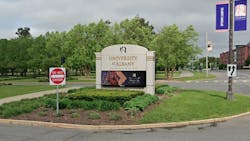$30 million decarbonization project begins at University at Albany
A $30 million decarbonization project at the University at Albany will enable the campus to shut down its gas-fired boilers during the summer months and significantly reduce its fossil fuel consumption.
The university says it will replace two gas-fired absorption chillers in the university’s 1960s-era central power plant on the Uptown Campus with a high-efficiency electric centrifugal chiller and a heat recovery chiller connected to a new geothermal well field in the Dutch Quad parking lot.
“This decarbonization project is a major step in reducing our campus greenhouse gas emissions and embodies our resolve to lead on climate by example," UAlbany President Havidán Rodríguez said.
UAlbany’s chiller project modifies domestic hot water systems in more than 25 buildings and installing new low-temperature hot water piping in the campus’ athletic facilities. These upgrades will enable the campus to shut down its gas-fired boilers during the summer months and use the new geothermal heat recovery chiller to meet cooling as well as 100% of heating and domestic hot water loads during the summer.
The new geothermal heat recovery chiller will also provide 100% of the heating, cooling and domestic hot water to achieve an all-electric renovated Physical Education building.
The new Dutch Quad geothermal well field will have between 90 and 135 wells dug as deep as 800 feet—smaller in footprint but nearly 300 feet deeper than the geothermal wells at UAlbany’s ETEC building on the Harriman State Office Campus.
Overall, the project will reduce the university's annual natural gas usage by an estimated 16% even as it adds additional cooling capacity.
Also this month, crews will be drilling test geothermal wells in the State Quad parking lot for UAlbany’s proposed $250 million Health Innovation & Technology Building, which will house a satellite Energy Hub with additional heat-recovery chillers.
In addition to the labs and teaching spaces inside the Health Tech building, the new satellite Energy Hub and associated geothermal well field would help sustainably heat and cool 700,000 square feet of adjacent buildings on the Academic Podium while reducing the campus’ fossil fuel consumption by an additional estimated 16%.
Combined, the central Power Plant upgrades and Health Tech building could reduce the fossil fuel consumption on the Uptown Campus by as much as one-third.
About the Author
Mike Kennedy
Senior Editor
Mike Kennedy has been writing about education for American School & University since 1999. He also has reported on schools and other topics for The Chicago Tribune, The Kansas City Star, The Kansas City Times and City News Bureau of Chicago. He is a graduate of Michigan State University.
